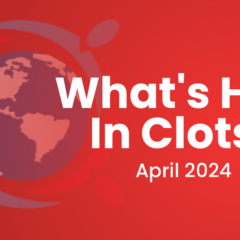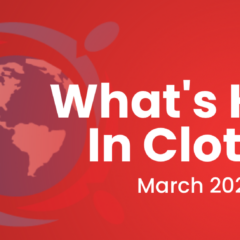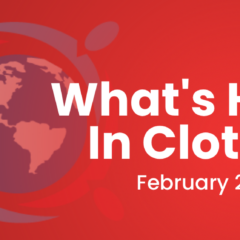Published on
Clot Chronicles: Trial Takeaways from ESC 2021
Hello, this is Christian Ruff. It is a pleasure to talk to you today for the NATF Clot Chronicles ESC 2021 recap – quite an exciting European Society of Cardiology Conference and a lot of great late-breaking science. I thought I would share with you some of the highlights that are particularly relevant for our NATF Community.
Some important studies regarding antiplatelet therapy in coronary disease were presented and published at the European Society of Cardiology. Two had to do with duration of dual antiplatelet therapy (DAPT). One was MASTER-DAPT and that was looking at the management of high-bleeding risk patients after they received a bioresorbable polymer-coated stent. They were studying these high-risk bleeding patients and whether shorter or longer duration of DAPT was effective or safe.
They randomized patients to who had recently undergone percutaneous coronary intervention (PCI) in the last 30-44 days into two potential groups. One group stopped DAPT immediately and just continued on single antiplatelet therapy and then the other, the standard group, continued DAPT for five months and then transitioned to single antiplatelet therapy. The results were pretty interesting (and basically consistent) in that patients—who were either on abbreviated DAPT or standard DAPT—that those regimens were similar to each other with regard to net adverse clinical outcomes, which was a composite of both ischemic events and bleeding events. So, certainly, in an all-comers population of patients who had recent percutaneous interventions, a shorter duration of DAPT is certainly reasonable.
Now this stands in contrast, interestingly, to a second study that was presented, the STOPDAPT-2 ACS Study. Now this is a follow-on study from the original STOPDAPT-2, which had a similar message to MASTER-DAPT. They took patients, a mix of patients who had stable coronary disease or acute coronary syndrome (ACS), and randomized them to either one month of DAPT followed by clopidogrel monotherapy or more traditional DAPT for 12 months. That study basically showed that being on a shorter duration of DAPT was equally as effective and had less bleeding.
But the investigators wanted to know whether this were true if you look specifically at patients who had ACS. Remember, these are higher-risk patients, they just had a clot, they have more activated platelets, and there is more of a concern about potentially stopping DAPT prematurely. In this study, in contrast to the others, one month of DAPT followed by clopidogrel in patients with ACS undergoing PCI did not lead to lower rates of cardiovascular and bleeding events compared to 12 months of DAPT.
So, I think there is a very important difference in this study; shorter duration of DAPT failed to achieve noninferiority for net clinical benefit probably because these are higher-risk patients with ACS soon after their intervention. I think when you have patients with coronary disease and you are trying to figure out the duration of DAPT, you really have to consider two things: do they have a high bleeding risk that might sort of favor shorter durations of DAPT? Then, remember your patients with ACS are at higher risk and so they have higher thrombotic events and, if you can, longer duration of DAPT may be better to reduce their ischemic burden.
There was also some very exciting data presented regarding atrial fibrillation (Afib) with patients who also had valvular disease. One was the ENVISAGE-TAVI AF Study, which studied edoxaban versus warfarin following heart valve replacement, particularly TAVI. We know that edoxaban was compared to warfarin in all types of Afib patients in the ENGAGE AF-TIMI 48 Trial, which showed edoxaban to be as effective as warfarin in reducing stroke and far safer with respect to serious bleeding, as well as all-cause major bleeding.
In this study, interestingly, edoxaban was noninferior to warfarin with respect to a composite efficacy outcome of adverse clinical events in patients who had Afib but also underwent TAVI – but there was actually more bleeding, which was in contrast to the ENGAGE study and, in particular, with regard to gastrointestinal (GI) bleeding. We know that although the non-vitamin-K oral anticoagulants (NOACs) caused far less serious bleeding than warfarin, many of the agents have an excess of GI bleeding. This population is also usually receiving antiplatelet therapy in addition to their anticoagulant and that really exacerbated the GI bleeding, in particular in the edoxaban group. So, I think this is an important study that certainly shows that in patients at very high risk of GI bleeding,NOACs do not necessarily have a clear safety advantage.
Now, shifting gears a little bit, but still in the Afib field, we know that obviously anticoagulation is the standard of care for reducing a thromboembolic risk (particularly stroke), but there are nonpharmacologic opportunities: left atrial appendage occluder devices. There was an interesting study, the AMULET IDE, which compared one type of device, the Amulet™ left atrial appendage (LAA) occluder versus the Watchman™. In this study, which was very interesting, they basically compared these two occluder strategies. The primary endpoint, a composite of ischemic events, mortality, and bleeding, was similar between the two endpoints.
So, I think that is important as far as the clinical outcome, but it was not really powered to note a clinical difference; however, one of the things that is important when you put in these devices is how well they seal the left atrial appendage. Are there any gaps that could potentially let a clot out? When they did this type of imaging, it actually appeared like the Amulet LAA occluder was superior to the Watchman in achieving complete closure of the LAA. Now, whether in a larger study that would lead to fewer strokes, or potentially even to eliminating the need for anticoagulation in these patients, is unknown. But it’s certainly promising that you may get more complete closure of the LAA and that could potentially, in a larger study, lead to reduction in ischemic stroke.
One of the other things I think we have been struggling with is how much should we look for Afib. We know Afib increases the risk of stroke, so wouldn’t it be great if we could catch Afib earlier and start anticoagulation? There was an interesting study, the LOOP Study that looked at continuous monitoring. If they detected Afib and patients got started on anticoagulation, could you reduce the risk of stroke? They randomized over 6,000 patients in Denmark to an implantable loop recorder and indeed, they identified more Afib, 31.8% in the loop recording group compared to only 12.2% of patients in the standard group. As would be expected, anticoagulation was initiated more frequently in the monitored group, but it did not translate to a significant reduction in ischemic stroke.
Now, there was a nonsignificant trend, a 20% reduction in both ischemic stroke and all-cause mortality. So, I think how I interpret this study is if you look for Afib, you’ll find it. Whether you start anticoagulation and whether that improves patient outcomes or reduction in stroke is unknown, but there certainly was a signal here – nonsignificant, but perhaps in a larger study there may be a potential benefit. However, it also gives us caution that the type of Afib you may pick up when you look for it in an asymptomatic patient may not be the same type of Afib that we see when a patient shows up with palpitations with clinical Afib.
Now, let’s shift gears to some exciting presentations regarding COVID-19 and the risk of venous thromboembolism (VTE). One of the highlights of ESC was the MICHELLE study looking at medically ill patients who were hospitalized for COVID-19. We know that population is at risk for VTE. The study looked at these patients discharged from the hospital and whether extended prophylaxis with rivaroxaban reduced their risk of ischemic events.
I think there was a very exciting finding. The primary endpoint for this trial, which was symptomatic VTE, VTE-related death, or bilateral VTE, as well as MI, non-hemorrhagic stroke and other adverse limb events, was significantly reduced, only around 3% in the rivaroxaban group compared to over 9% in the control group with very, very low rates of bleeding, really 0% for major bleeding. So, I think this is a very provocative study. In hospitalized patients who are medically ill, who are at risk for VTE, extended prophylaxis with rivaroxaban was incredibly beneficial for reducing their risk of thrombotic events. There are other studies like this also being presented and published, which will help inform whether we should be routinely prophylaxing both inpatients and outpatients who have COVID.
Then, an incredibly important epidemiologic study was also presented, the SSaSS study, which was a salt substitution study from China. Here in this interesting study, they took 600 rural villages in China, about 21,000 participants, and randomized them to either a salt substitute or regular salt and they wanted to show, by using a salt substitute, that you would reduce the risk of all sorts of adverse cardiovascular events. Basically, they found that major cardiovascular events were indeed reduced with the salt substitute, including a reduction in all-cause mortality, which was pretty impressive.
So, this shows that a simple cost-effective approach at a large scale could substantially reduce cardiovascular burden. One of the caveats, however, is that these salt substitutes can increase the risk of hyperkalemia and there wasn’t routine monitoring of that in this study – so that is one thing in additional studies, the safety, that I think needs to be looked into with more caution.
Another, I think important, landmark study was the IAMI study, which looked at patients who came into the hospital with MI or who had PCI, so patients with active coronary disease, and looked whether giving them the influenza vaccine soon after their event improved patient outcomes. This trial was published in Circulation, and they enrolled over 2,500 patients and then randomized them to the flu vaccine or placebo within 72 hours of their event or hospitalization. Very importantly, there was a substantial reduction in both the rates of the composite outcome, which was a mix of thrombotic events and mortality, but also a significant reduction in all-cause mortality by 41% in cardiovascular death by a similar magnitude.
So, giving the flu vaccine to high-risk cardiac patients early after an MI appears to lower the risk of mortality and stent thrombosis. So, I think this will be a very important tool in our armamentarium to protect patients, not only focusing on their coronary disease, but we know that if they do happen to get influenza that it could have very serious consequences for someone who is hospitalized for cardiovascular disease.
I think to end, there was a very provocative study for me, as a coffee drinker. There has obviously been intense debate regarding the benefits and risks of caffeine consumption, particularly coffee. There have been lots of studies looking at coffee drinking and they have had mixed results. I think this is one of the best ones that was presented. This was looking at a very large group of patients from the UK Biobank, approximately 470,000 patients followed for 11 years. The study looked at whether coffee consumption was associated with cardiovascular benefit or risk and they actually found a very interesting finding that up to 3 cups of coffee is associated with a lower risk of stroke and fatal heart disease in this study.
What is interesting about this study is they had a very important mechanism for a sub-study; they had a bunch of cardiac MRIs in about 30,000 or 31,000 of these participants. They looked at not only whether there a reduction in clinical events, but was there an explanation for this, was there biological reason why these patients might have cardiovascular protection? It was interesting that compared to patients/subjects who did not drink coffee, daily consumers of light to moderate coffee consumption had healthier-sized and better functioning hearts, which at least gives some biologic plausibility that some amount of coffee drinking may actually be associated with reversing the detrimental effects on aging of the heart. Again, much more work needs to be done. This doesn’t prove that coffee drinking is helpful, but I think it’s one of the first large studies that tries to link outcomes with coffee drinking with potential mechanisms. So, I am certainly very relieved by that, considering I am at least a light-to-moderate coffee drinker myself.
So, I’m delighted that I could share this very exciting late-breaking science with you from the European Society of Cardiology 2021, and I look forward to sharing more science with you from future conferences.
Thank you!



